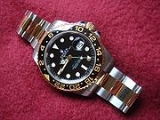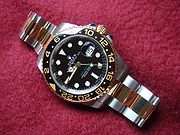
Rolex GMT Master II
Encyclopedia

Rolex
Rolex SA is a Swiss watchmaking manufacturer of high-quality, luxury wristwatches. Rolex watches are popularly regarded as status symbols and BusinessWeek magazine ranks Rolex No.71 on its 2007 annual list of the 100 most valuable global brands...
Professional Watch Collection. Designed in collaboration with Pan Am Airways
Pan American World Airways
Pan American World Airways, commonly known as Pan Am, was the principal and largest international air carrier in the United States from 1927 until its collapse on December 4, 1991...
for use by their pilots and navigators, it was launched in 1954.
History
The Rolex GMT-Master wristwatch was originally designed in collaboration with Pan Am AirwaysPan American World Airways
Pan American World Airways, commonly known as Pan Am, was the principal and largest international air carrier in the United States from 1927 until its collapse on December 4, 1991...
and issued by the airline to their crews on transcontinental long-haul flights. ("GMT" in the name stands for Greenwich Mean Time
Greenwich Mean Time
Greenwich Mean Time is a term originally referring to mean solar time at the Royal Observatory in Greenwich, London. It is arguably the same as Coordinated Universal Time and when this is viewed as a time zone the name Greenwich Mean Time is especially used by bodies connected with the United...
). The watch has a convenient capability that was unique at the time as it enabled the crews to have GMT or another second time zone displayed. GMT is the time zone that is required for all aviation planning, weather forecasts, schedules and other paperwork. In addition as Inertial Navigation
Inertial navigation system
An inertial navigation system is a navigation aid that uses a computer, motion sensors and rotation sensors to continuously calculate via dead reckoning the position, orientation, and velocity of a moving object without the need for external references...
and Global Positioning System technologies did not yet exist, and aircraft were out of range of normal radio navigation beacons during transoceanic flights, an accurate GMT time source was essential for use with specialist sextants for astronavigation (obtaining geographical position by relative angles of the horizon, the sun and other stars). In fact the very first “Marine Chronometers” (the predecessors of more modern mechanical watches) were specifically developed for use in astronavigation on ships during the 18th century.
The second time zone on the watch also proved a great help to crews for managing jetlag and for communications home when abroad. It is this capability that has made them very popular with businessmen and other travellers. They have also been particularly popular with NASA and military pilots and many soldiers and sailors who often require GMT or a second time zone.
In the early 1980s the Rolex GMT-Master II was released (although production of the original version continued alongside it until the late 1990s). Although the watch looks almost identical it uses a movement that has the additional capability of a quickset hour hand that can be adjusted to local time without stopping the seconds or disturbing the minutes and 24 hour GMT hand. As the watch continues to feature the rotatable bezel it is now able to display a third time reference.
The Rolex GMT 24 hour hand feature has been adopted by many other watch manufacturers and is now a relatively common feature. However nearly all of these watches use an ETA movement that is operated slightly differently from the Rolex GMT-Master II design (the 24 hour hand is quickset rather than the local hour hand) and whilst perfectly usable, it is a slightly less convenient design for pilots and regular travellers but very suitable for those staying at home and wishing to track a time zone in another country (e.g. Telephone calls for business or relatives abroad). Omega are one exception as they operate in the same way as the Rolex GMT-Master II.
Although the original Rolex GMT Master was only available in Stainless Steel, as it was conceived as a functional, work watch, Rolex have been making luxury versions in both mixed steel and gold and all gold since the 1970s and there are even exotic variations that incorporate elaborate designs that include precious stones. All variants have significantly increased in their purchase cost relative to inflation and are now often regarded as high luxury or status symbols. In spite of this they still make a very accurate and robust work watch that is very well suited to its original design purpose and with their all metal construction, shock proofing and water-resistance they still remain popular amongst pilots today.
50th anniversary edition
An updated Rolex GMT Master II was released in 2005. This new model features a number of technical changes, such as Rolex's patented Parachrom hairspring as well as a larger Triplock crown (from the diver's watches). The new model also has several cosmetic changes, such as larger case, hands and hour markers and also a new bezel made using an extremely hard ceramic material that is designed to be more scratch and fade resistant. Also included in the update is a new and more luxurious style of bracelet that has heavier solid links and a machined clasp. The stainless steel version now joins the precious metal versions by having highly polished centre links on its bracelet which gives the watch a more dressy appearance but can be prone to scratches when used as an every day watch.External links
- Rolex.com - Official Rolex Website
- GMT Master History - good overview over the evolution of the Rolex GMT Master
The 50th anniversary model has a green "GMT" hand (forth hand) and the words GMT MASTER II on the face are also in green. Green has traditionally been used by Rolex to denote watches that have been in continuous production for 50 years. The updated GMT Master II also has the new in house produced hairspring, dubbed by Rolex as the "Parachrom hairspring". The new hairspring is made of a new Non Ferromagnetic alloy which has a distinct blue colour. The hairspring is reported to be less susceptible to magnetic fields and more resistant to shocks, leading to a more accuracy timepiece. The watch has been nicknamed the GMT II C to distinguish it from its predecessors.

